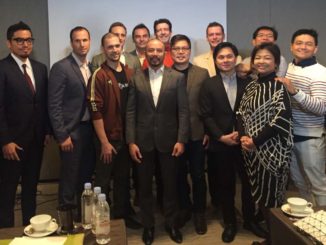
Brian Cu, Country Head, Grab Philippines

Grab started in the Philippines in 2013 as Grab taxi which is a ride-hailing platform that utilize taxis with existing franchises to provide passengers with the means to more easily get a ride and drivers with better utilization of their time on the road. Since then, Grab expanded to accommodate various types of transport services, the most popular being Grab car, the subject of today’s hearing.
We started the Grab cars services in 2015, the same year, the first policy in Southeast Asia regulating these types of services was promulgated by then DOTC. I’ll not go into this because Ma’am Aileen has already explained.
One of the necessary steps in the application in the activation process is to secure a provisional authority or CPC. On July 21, 2016, the LTFRB put a stop in accepting new applications for PAs and CPCs.
And we, as Grab admitted during the hearing on July 11, 2017 to have continued activating drivers on the platform despite the suspension order. Since the suspension, however, we have attempted a number of times to initiate dialogue with the regulators and only now after 11 months, we have actually sat down with them and Ernest.
And understandably, the nature of our highly competitive data requires us to be very careful about sharing it but we’ve then since disclosed a lot of this data both in hearings in the technical working groups and we will do so again today.
Grab drivers
 Not all drivers are active at the same time. In fact, only five to 8,000 drivers are active on an hourly basis. So you can see from this that the notion that TNCs and TNVS have added a staggering number of cars on the road is a bit exaggerated. In fact, as mentioned by Chairperson Poe, we have not seen any study that confirms whether or not the services that we deliver have worsened the traffic situation.
Not all drivers are active at the same time. In fact, only five to 8,000 drivers are active on an hourly basis. So you can see from this that the notion that TNCs and TNVS have added a staggering number of cars on the road is a bit exaggerated. In fact, as mentioned by Chairperson Poe, we have not seen any study that confirms whether or not the services that we deliver have worsened the traffic situation.
About 60% of the drivers here are part-time drivers. These part-time drivers would go online during critical hours that they are needed, particularly the morning and evening peak periods, either going to work or leaving the office.
It is this flexibility that emphasizes the benefits of a business like ours. And even what may seem as a high number of vehicles, the supply online is still unable to meet the demand.
Currently, we’re only able to serve around 70% of the demand, and we can say that because we know the actual numbers that comes through the platform because these cars cannot pick up on the road. And I don’t think any other mode of transport can say that because the richness of data that we have, they don’t.
Not taxi service
Lawmakers and the taxi industry operators have oftentimes likened us to the traditional taxi service. I’d like to address that with four points.
First is the fare setting mechanism. Our dynamic pricing algorithm takes in multiple variables that a simple taxi meter cannot, and sets an optimal price where supply and demand would find a balance.
Our standards of safety are also at, you know, the best standards in the industry because drivers can only serve rides from the application they hold, and we can suspend drivers or passengers real time should there be any incidence reported to Grab. The drivers are also rated by passengers after trips on which action can be taken should the experience not be satisfactory.
Most importantly, our backend infrastructure. Grab has invested millions to build out our backend infrastructure such as training centers for our peers and drivers, a 24-by-7 call center, mall terminals and a scalable system that can accommodate the growth in demand. We’re more than just an app, that’s what I would like everyone to understand.
The infrastructure that sits behind what you see on your phone is much richer than what people seem to understand.
And, of course, the investment behind the service. If you talk about foreign direct investments into the country, Grab Philippines or Grab Inc., has invested into the Philippines tens of millions of dollars in the last four years.
The investment has translated into, of course, higher tax revenue for the government, but also more importantly, savings for our commuters through promos—and everyone loves promos—and to driver incentives which resulted in up to 30% higher income for our TNVS versus the average daily wage in the country.
The app is more than just a simple technology solution. We’ve always taken the view, as Grab, to work with the regulators to find the optimal balance between regulation and innovation. And it is our sincere hope that this Committee would continue to pave the way for active collaboration between private sector and the regulators, and that in the coming days and weeks we would work towards a legislation that will uplift the ride-hailing industry and further strengthen the commitment to protect the welfare of passengers and drivers alike.



